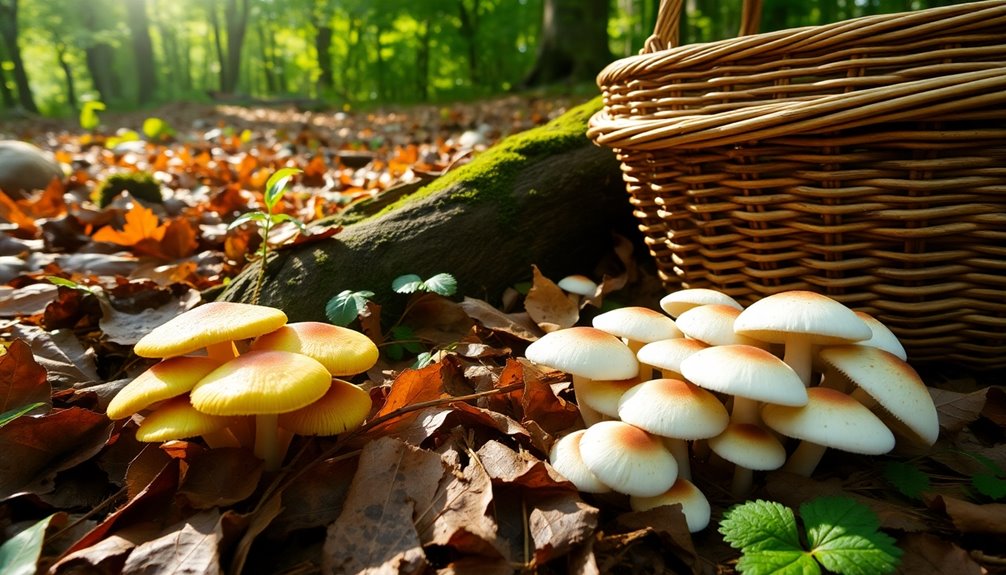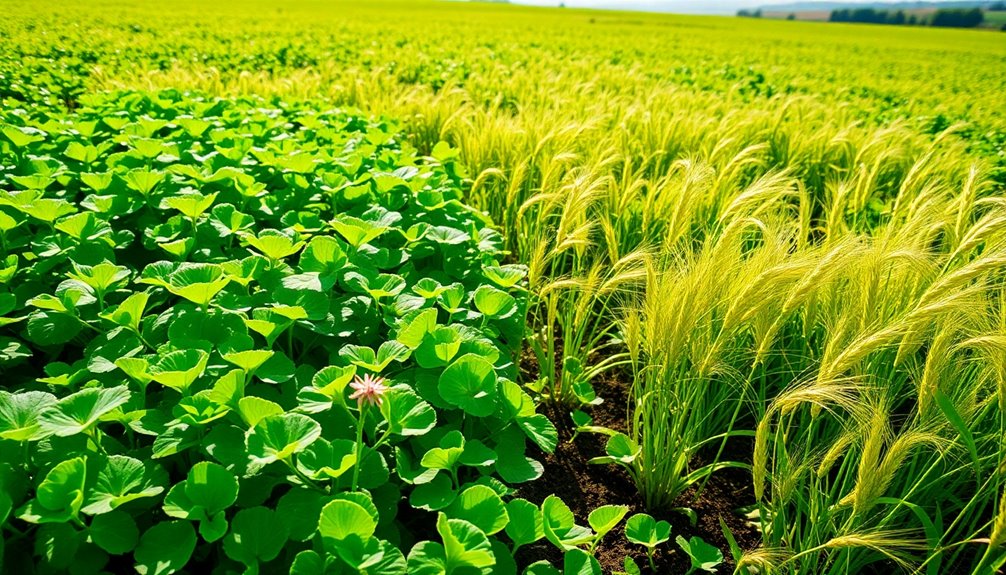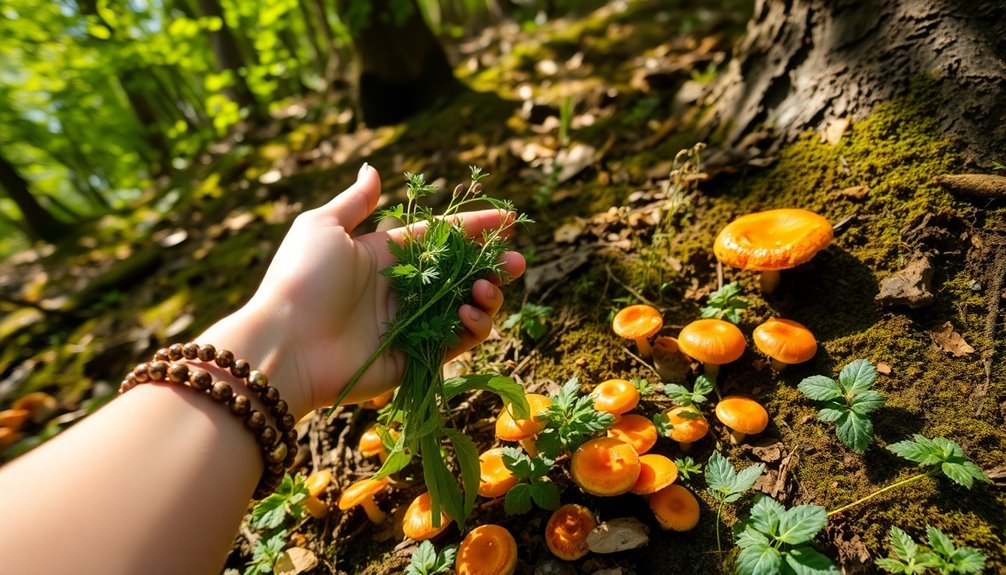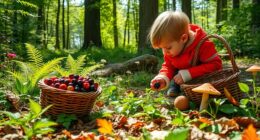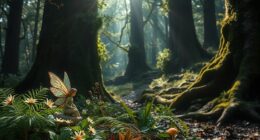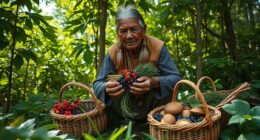Mushroom foraging season usually peaks in spring and fall. In spring, hunt for morels after rainfall, when temperatures are warm. Fall is ideal for chanterelles and oyster mushrooms, especially as the weather cools. You'll want to forage 3-7 days after a good rain for the best results. Look in wooded areas near dying trees or urban parks with mature vegetation. Equip yourself with a basket, knife, and field guide, and always double-check your finds for safety. If you want to maximize your foraging skills and knowledge, there's a lot more to uncover!
Key Takeaways
- Spring (March to May) is optimal for foraging morels, especially after rainfall and warming temperatures.
- Fall (September to November) yields peak foraging for chanterelles and oyster mushrooms during cooler weather.
- Look for moist woodland areas near dying elms and ash trees for morel mushrooms.
- Urban parks with mature trees often host diverse mushroom species for foragers to discover.
- Seasonal exploration enhances foraging success, as different species appear throughout the year.
The Importance of Fungi

Fungi play an essential role in maintaining healthy ecosystems, acting as nature's recyclers. They break down decomposing organic matter, returning important nutrients to the soil and supporting plant growth. This nutrient recycling is fundamental for the overall health of ecosystems, as it enhances soil structure and fertility. In many regions, such as Wisconsin's wild bounty(Wisconsin's-Wild-Bounty), diverse fungi species contribute to the richness of the local flora and fauna.
You mightn't realize it, but mycelium—the vegetative part of fungi—forms intricate networks within the soil. These networks help plants absorb nutrients and water through symbiotic relationships known as mycorrhizae. In this mutualistic partnership, fungi enhance the nutrient uptake of plants while receiving carbohydrates produced through photosynthesis in return. This collaboration is crucial for thriving ecosystems.
Moreover, the diversity of fungi contributes considerably to biodiversity, supporting various wildlife that depend on these organisms for food and habitat. Organic gardening practices often benefit from the presence of diverse fungi, as they enhance soil health and promote robust plant growth.
The presence of different fungi species improves soil structure, allowing better water retention and aeration, which is essential for plant health. Understanding the importance of fungi in ecosystems can deepen your appreciation for these remarkable organisms and their critical functions.
As you explore the world of mushroom foraging, remember that these fungi are vital for our environment's well-being.
Preparing for Mushroom Foraging
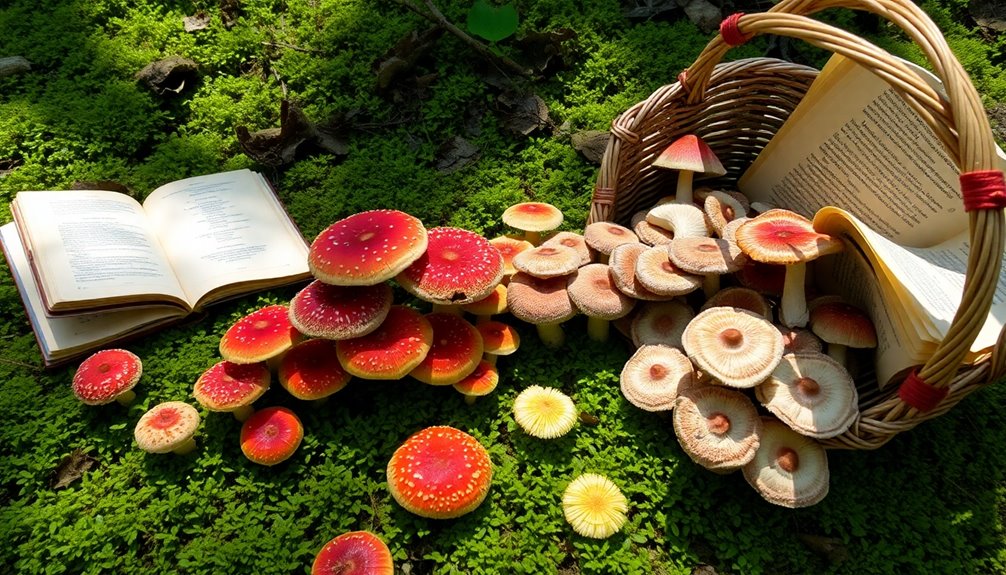
When you're ready to explore the world of mushroom foraging, proper preparation is key to ensuring a safe and successful outing. Start by gathering essential gear: a sturdy basket for collecting, a sharp knife for harvesting, and a reliable field guide to assist with identification. Wearing protective clothing can also help you navigate through the spring woods comfortably.
Before you head out, inform someone about your foraging plans and carry a first aid kit for emergencies. Familiarize yourself with local regulations regarding permits, especially on public lands, to avoid any legal issues.
Timing is vital; aim to forage 3-7 days after rainfall when temperatures range from 60-70°F for the best chance of finding edible mushrooms.
Consider using technology by downloading smartphone apps that assist in identification and joining local Mycological Association groups to enhance your knowledge. These hunting tips won't only improve your skills but also connect you with fellow foragers.
Identifying Edible Mushrooms
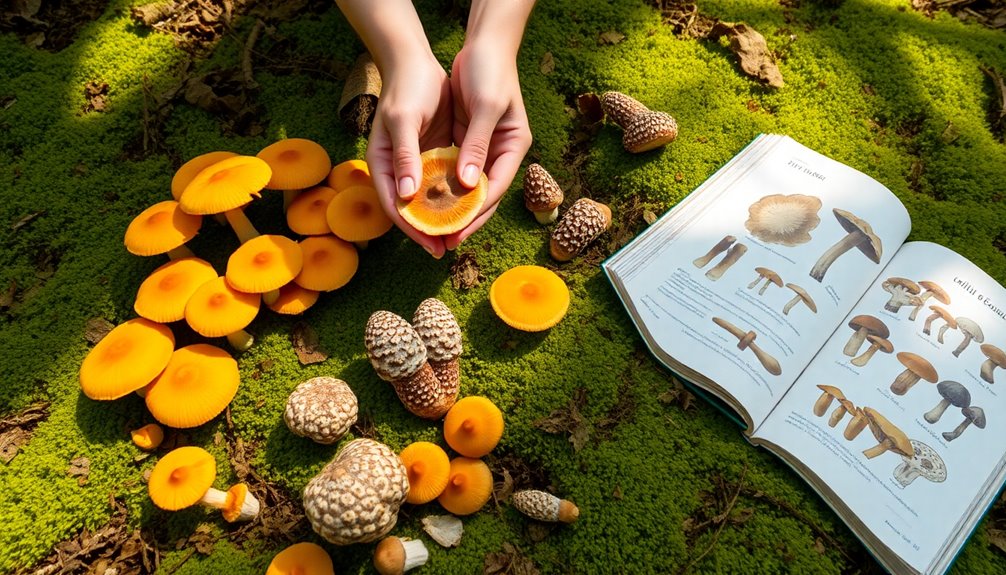
When you're out foraging, knowing how to identify edible mushrooms is essential.
Pay attention to key features like the honeycomb appearance of morels or the bright caps of Texas golden chanterelles.
Always be aware of toxic look-alikes, as some mushrooms can closely mimic safe varieties.
Key Identification Features
Often, identifying edible mushrooms requires keen observation and attention to detail. When hunting for mushrooms, you'll need to focus on key identification features that distinguish edible varieties from toxic look-alikes.
For instance, morels are famous for their distinct honeycomb appearance and hollow stems, typically found under hardwoods in the spring.
Oyster mushrooms can be identified by their fan-shaped caps and off-center stems, often growing in clusters on decaying wood.
If you're lucky enough to spot a Texas golden chanterelle, you'll recognize it by its bright yellow-orange hue and wavy cap edges.
Puffballs are another edible option, but verify they've pure white interiors when cut open, signaling they're safe to eat.
Common Edible Varieties
Mushroom foraging opens up a world of delicious possibilities, especially when you know how to spot common edible varieties.
Morels, with their distinctive honeycomb appearance, are a prized find for mushroom hunters, typically popping up in spring under hardwoods and conifers. Their unique flavor makes them a favorite among foragers.
Another delicious option is oyster mushrooms, recognizable by their fan-shaped caps and clusters growing on decaying wood. These mushrooms bring a mild flavor to various dishes, making them a fantastic addition to your culinary adventures.
If you're foraging during summer, keep an eye out for bright yellow-orange chanterelles, known for their fruity aroma and preference for moist, wooded areas.
You can also search for the Chicken of the Woods, identifiable by its bright orange color and smooth surface, often found on dead or dying trees.
Toxic Look-Alikes Awareness
While foraging for delicious mushrooms can be an exciting adventure, it's important to be aware of the toxic look-alikes that can pose serious risks. Edible morel mushrooms, for example, can easily be confused with toxic false morels. The latter has a lobed or irregular cap and can cause severe illness if consumed.
Similarly, the notorious death cap resembles the edible straw mushroom, making proper mushroom identification critical.
Another common mistake is confusing the Jack o' Lantern mushroom with the edible chanterelle. While chanterelles have ridges, Jack o' Lanterns glow in the dark and feature gills that run down their stems.
It's crucial to note that some species of the Gyromitra genus, especially Gyromitra esculenta, may look similar to morels but are highly toxic.
To guarantee your foraging experience is safe, always consult multiple reliable sources or field guides for mushroom identification. This practice is especially important when you're in areas with abundant edible mushrooms.
Recognizing Poisonous Varieties
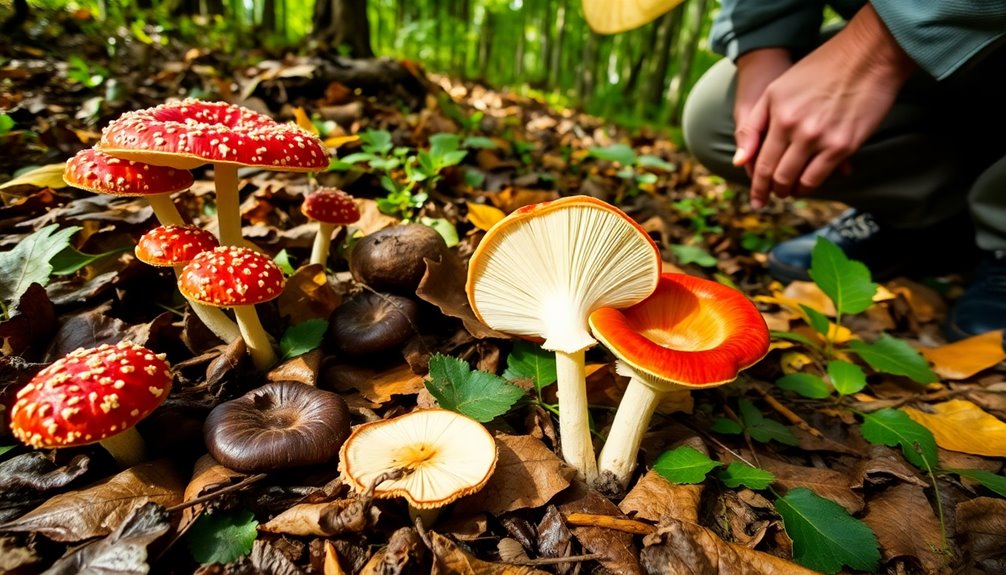
Recognizing poisonous varieties is essential for safe foraging. As you venture into the domain of mushrooms, knowing the distinguishing features of toxic varieties can save you from a dangerous mistake.
Familiarize yourself with the Amanita species, particularly the infamous death cap and destroying angel, which sport white to pale yellow caps and white gills.
Be cautious of false morels; while they may look like edible varieties, their irregular, lobed caps are a warning sign, and they're not hollow, making them potentially toxic.
Additionally, certain Gyromitra species can be confused with safe mushrooms but contain harmful toxins.
Keep an eye out for mushrooms exhibiting dark spots, wilting, or unusual colors—these may signal spoilage or toxicity.
- Always consult multiple reliable sources or field guides for accurate identification.
- Be aware that many edible mushrooms have poisonous look-alikes.
- Trust your instincts; if it doesn't look right, avoid it.
- Educate yourself continuously to enhance your morel mushroom hunting skills.
With these tips, you'll better navigate the domain of mushrooms, ensuring a safer and more rewarding foraging experience.
Best Foraging Locations
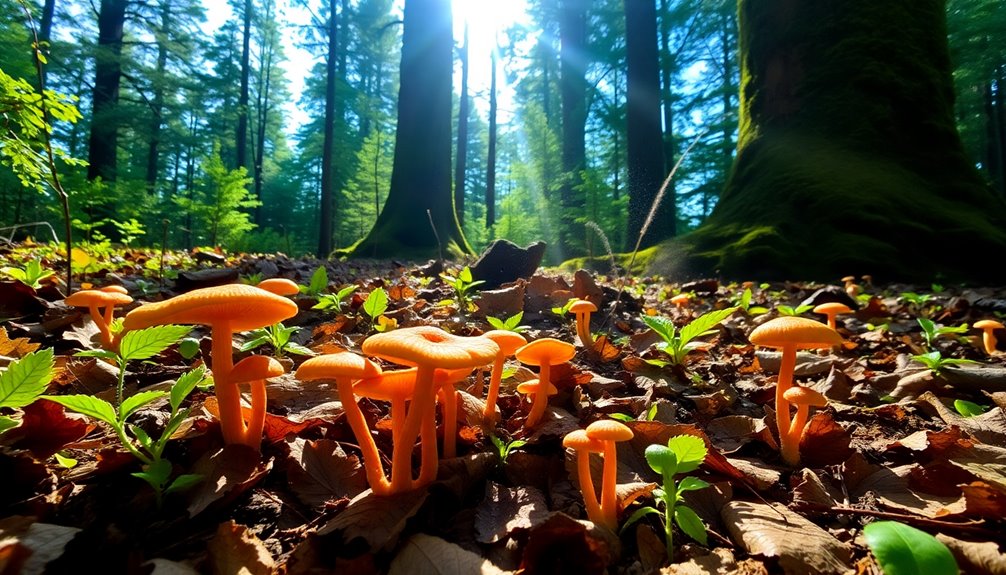
When it comes to finding the best foraging spots, Central Texas stands out, especially around Lost Pines near Bastrop. This region's dense forest habitats are perfect for hunting a variety of edible mushrooms.
You'll find some of the best pheasant back mushrooms thriving here, particularly in late April when conditions are just right.
If you're willing to venture a bit further, North Texas offers wooded areas near lakes and rivers, ideal for finding species like oyster mushrooms and chanterelles.
Don't overlook urban parks, either; these well-established green spaces often yield surprising finds. Mature trees in city parks can be a goldmine for mushroom hunting.
In spring, keep an eye out for morels, which love moist woodland areas, especially near dying trees like elms and ash.
Pine forests in East Texas are another fantastic option, known for unique varieties like saffron milk caps.
Whether you're exploring Central Texas or beyond, each location provides a unique experience in North America's vibrant mushroom scene.
Happy foraging!
Seasonal Patterns in Foraging

As you explore the best foraging locations, it's important to understand the seasonal patterns that dictate mushroom availability. Wild mushrooms grow in response to specific environmental conditions, and recognizing these can enhance your foraging success.
- Spring (March to May): This is the prime foraging time for morels, which thrive after consistent above-freezing temperatures and rainfall.
- Fall (September to November): Peak season for prized edibles like chanterelles and oyster mushrooms, coinciding with cooler temperatures and increased moisture.
- Rainfall patterns: Ideal conditions for foraging typically occur 3-7 days after notable rain events, so keep an eye on the forecast.
- Temperature variations: Seasonal variations in temperature, preferably between 60-70°F, greatly boost your chances of finding mushrooms.
Different habitats, such as East Texas pine forests or Central Texas dense woods, impact the availability of various mushroom species.
Culinary Uses for Foraged Mushrooms

Foraged mushrooms can elevate your cooking by adding unique flavors and textures to a variety of dishes. Incorporating foraged mushrooms like chanterelles into your meals can enhance the culinary experience considerably. Their distinct flavor profile pairs beautifully with eggs, light meats, and creamy sauces, making them a delightful addition to breakfast or dinner.
Morels, with their honeycomb appearance, are prized for their earthy taste. You can stuff them or blend them into gourmet sauces for a rich, savory dish that impresses every palate.
If you're looking for versatility, oyster mushrooms are your go-to. Their mild flavor and tender texture work wonders in stir-fries, soups, or as a vegetarian meat substitute.
Don't overlook the vibrant Chicken of the Woods mushrooms, which can replace chicken in recipes. Their meaty texture and flavor appeal to both vegetarians and meat-eaters alike.
Try incorporating wild mushrooms into traditional dishes, such as creamy pasta with morels or cornbread stuffing with chanterelles. By doing so, you not only enhance the flavor but also celebrate the local foraging culture in your culinary creations.
Sustainable Foraging Practices
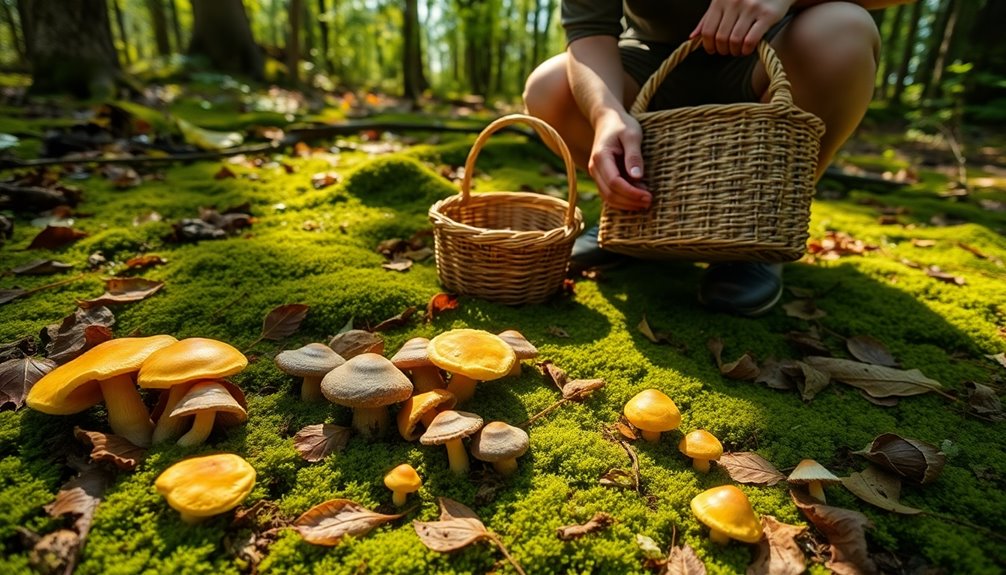
Sustainable foraging practices are vital for preserving mushroom populations and their ecosystems. By adopting these methods, you not only enjoy the thrill of foraging but also help guarantee that future generations can do the same.
Here are some key principles to follow:
- Harvest no more than one-third of any given patch, allowing mushrooms to reproduce and thrive.
- Educate yourself on local regulations regarding mushroom harvesting to protect fungal populations.
- Prioritize proper identification of edible versus toxic species to avoid damaging ecosystems, as some mushrooms are essential for nutrient cycling.
- Embrace the "Leave No Trace" principle to minimize your environmental impact, keeping habitats undisturbed for wildlife and future foragers.
Engaging with community resources, such as local mushroom clubs and workshops, can deepen your understanding of the ecological importance of fungi.
By connecting with others, you'll enhance your skills and knowledge about sustainable foraging practices.
Remember, responsible mushroom harvesting not only enriches your culinary adventures but also supports the health of your local ecosystems.
Frequently Asked Questions
What Months Are Best for Mushroom Hunting?
The best months for mushroom hunting are typically March to May and September to November.
During spring, warmer temperatures and increased rainfall create ideal conditions for foraging morels and early fungi.
In fall, you'll find popular varieties like chanterelles and oysters.
Aim to go 3-7 days after significant rainfall, as this moisture helps stimulate growth.
Always check local habitats, like dense forests and water sources, to maximize your foraging success.
When Should I Start Hunting Morels?
To find morels, you'll need to watch the weather, track the temperatures, and observe nature.
Start your hunt in late April to early May, when soil temperatures hit around 50°F. Look for blooming dandelions, as they signal the right conditions.
Focus on southern-facing slopes and areas with dying or dead trees, especially elms and ashes.
Always confirm your identification, since false morels can be tricky.
Happy foraging!
What Is the Best Season for Mushroom Picking?
The best season for mushroom picking depends on the type you're after. In spring, you'll find morels thriving, especially after rainfall.
Fall is ideal for chanterelles and oyster mushrooms, which enjoy cooler temperatures. Keep an eye on the weather, as mushrooms often fruit 3-7 days after rain when soil temperatures sit between 60-70°F.
Local habitats also play a role, so familiarize yourself with your area to enhance your foraging success.
What Are the Rules for Mushroom Foraging?
When you're foraging for mushrooms, remember these essential rules: always get the necessary permits, respect private property, and familiarize yourself with local regulations.
Know what types and amounts you can collect, and practice sustainable foraging by only taking what you need. Leave some mushrooms behind to guarantee future growth.
Finally, be aware of seasonal restrictions to protect local ecosystems. Following these guidelines helps you enjoy foraging responsibly and ethically.
Conclusion
As you gear up for your mushroom foraging adventure, remember the thrill of discovery and the joy of connecting with nature. With the right knowledge and a bit of patience, you'll not only find delicious fungi but also deepen your appreciation for the ecosystem. So, why not step outside and embrace the adventure waiting in the woods? By foraging sustainably, you guarantee that future generations can enjoy this incredible experience too! Happy hunting!

